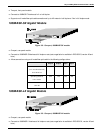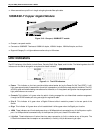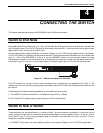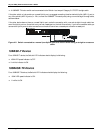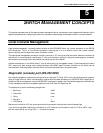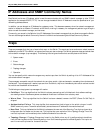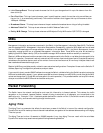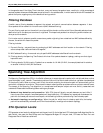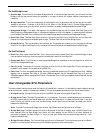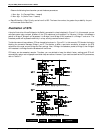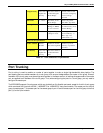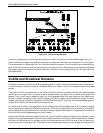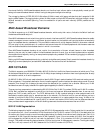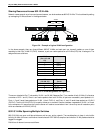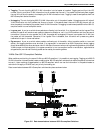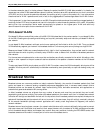
24-port NWay Ethernet Switch User’s Guide
18 Switch Management Concepts
On the Bridge Level
♦ Root Bridge The switch with the lowest Bridge Identifier is the Root Bridge. Naturally, you will want the Root
Bridge to be the best switch among the switches in the loop to ensure the highest network performance and
reliability.
♦ Bridge Identifier This is the combination of the Bridge Priority (a parameter that you can set) and the MAC
address of the switch. Example: 4 00 80 C8 00 01 00, where 4 is the Bridge Priority. A lower Bridge Identifier
results in a higher priority for the switch, and thus increases it probably of being selected as the Root Bridge.
♦ Designated Bridge From each LAN segment, the attached Bridge that has the lowest Root Path Cost to the
Root Bridge is the Designated Bridge. It forwards data packets for that LAN segment. In cases where all Switches
have the same Root Path Cost, the switch with the lowest Bridge Identifier becomes the Designated Bridge.
♦ Root Path Cost The Root Path Cost of a switch is the sum of the Path Cost of the Root Port and the Root Path
Costs of all the switches that the packet goes through. The Root Path Cost of the Root Bridge is zero.
♦ Bridge Priority This is a parameter that users can set. The smaller the number you set, the higher the Bridge
Priority is. The higher the Bridge Priority, the better the chance the Switch will be selected as the Root Bridge.
On the Port Level
♦ Root Port Each switch has a Root Port. This is the port that has the lowest Path Cost to the Root Bridge. In case
there are several such ports, then the one with the lowest Port Identifier is the Root Port.
♦ Designated Port This is the port on each Designated Bridge that is attached to the LAN segment for which the
switch is the Designated Bridge.
♦ Port Priority The smaller this number, the higher the Port Priority is. With higher Port Priority, the higher the
probability that the port will be selected as the Root Port.
♦ Path Cost This is a changeable parameter and may be modified according to STA specifications. Each 10Mbps
segment has an assigned Path Cost of 100, each 100Mbps segment has an assigned Path Cost of 19, and the
1000Mbps segment has an assigned Path Cost of 4. Please note if port trunking is enabled, these values will change
dynamically.
User-Changeable STA Parameters
The factory default setting should cover the majority of installations. However, it is advisable to keep the default settings
as set at the factory; unless, it is absolutely necessary. The user changeable parameters in the Switch are as follows:
♦ Bridge Priority A Bridge Priority can be from 0 to 65535. 0 is equal to the highest Bridge Priority.
♦ Bridge Hello Time The Hello Time can be from 1 to 10 seconds. This is the interval between two transmissions
of BPDU packets sent by the Root Bridge to tell all other Switches that it is indeed the Root Bridge. If you set a
Hello Time for your Switch, and it is not the Root Bridge, the set Hello Time will be used if and when your Switch
becomes the Root Bridge.
Note: The Hello Time cannot be longer than the Max. Age. Otherwise, a configuration error will occur.
♦ Bridge Max. Age The Max. Age can be from 6 to 40 seconds. At the end of the Max. Age, if a BPDU has still not
been received from the Root Bridge, your Switch will start sending its own BPDU to all other Switches for
permission to become the Root Bridge. If it turns out that your Switch has the lowest Bridge Identifier, it will
become the Root Bridge.
♦ Bridge Forward Delay The Forward Delay can be from 4 to 30 seconds. This is the time any port on the Switch
spends in the listening state while moving from the blocking state to the forwarding state.



